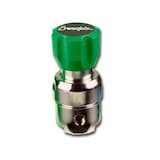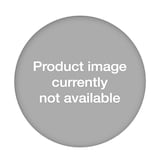Регуляторы
Regulators available with these specifications:
- Pressure-reducing models
- Back-pressure models
- Spring-, dome-, and air-loaded
- 1/4 to 4 in. end connections
- Working pressures up to 10 150 psig (700 bar)
- –49 to 176°F (–45 to 80°C)
担当のスウェージロック指定販売会社では、その他のオプションに対応している場合がございます。
-
Back-Pressure Regulators, Spring-Loaded — Back-Pressure Regulators
 担当のスウェージロック指定販売会社では、その他のオプションに対応している場合がございます。お問い合わせ型番ボディ材質一次側の最高使用圧力(20℃にて)二次側の圧力調整範囲ポートポート・パターン
担当のスウェージロック指定販売会社では、その他のオプションに対応している場合がございます。お問い合わせ型番ボディ材質一次側の最高使用圧力(20℃にて)二次側の圧力調整範囲ポートポート・パターンKBP1E0A4A5A20000 316 Stainless Steel 50 psig (3.4 bar) 0 to 50 psig (3.4 bar) 1/4 in. Female NPT A KBP1F0A4A5A20000 316 Stainless Steel 100 psig (6.8 bar) 0 to 100 psig (6.8 bar) 1/4 in. Female NPT A KBP1F0D4A5A20000 316 Stainless Steel 100 psig (6.8 bar) 0 to 100 psig (6.8 bar) 1/4 in. Female NPT D KBP1G0A4A5A20000 316 Stainless Steel 250 psig (17.2 bar) 0 to 250 psig (17.2 bar) 1/4 in. Female NPT A KBP1J0A4A5A20000 316 Stainless Steel 500 psig (34.4 bar) 0 to 500 psig (34.4 bar) 1/4 in. Female NPT A -
Pressure-Reducing Regulators, Spring-Loaded — Dual Stage
 担当のスウェージロック指定販売会社では、その他のオプションに対応している場合がございます。お問い合わせ型番ボディ材質一次側の最高使用圧力(20℃にて)二次側の圧力調整範囲ポートポート・パターン
担当のスウェージロック指定販売会社では、その他のオプションに対応している場合がございます。お問い合わせ型番ボディ材質一次側の最高使用圧力(20℃にて)二次側の圧力調整範囲ポートポート・パターンKCY1DRF412A20000 316 Stainless Steel 3600 psig (248 bar) 0 to 25 psig (1.7 bar) 1/4 in. Female NPT F KCY1ERF412A20000 316 Stainless Steel 3600 psig (248 bar) 0 to 50 psig (3.4 bar) 1/4 in. Female NPT F KCY1FRF412A20000 316 Stainless Steel 3600 psig (248 bar) 0 to 100 psig (6.8 bar) 1/4 in. Female NPT F KCY1GRF412A20000 316 Stainless Steel 3600 psig (248 bar) 0 to 250 psig (17.2 bar) 1/4 in. Female NPT F -
Spare Parts and Accessories — KPR Series Rebuild Kit
担当のスウェージロック指定販売会社では、その他のオプションに対応している場合がございます。お問い合わせ型番ボディ材質一次側の最高使用圧力(20℃にて)二次側の圧力調整範囲ポートポート・パターンKPR1D00412A0-KIT - 25 psig (1.7 bar) 0-10 psig (0.68 bar) and 0-25 psig (1.7 bar) 1/4 in. Female NPT - 9R0079 - N/A N/A N/A - KPR1F00412A0-KIT - N/A N/A N/A - -
Pressure-Reducing Regulators, Spring-Loaded — Single Stage
 担当のスウェージロック指定販売会社では、その他のオプションに対応している場合がございます。お問い合わせ型番ボディ材質一次側の最高使用圧力(20℃にて)二次側の圧力調整範囲ポートポート・パターン
担当のスウェージロック指定販売会社では、その他のオプションに対応している場合がございます。お問い合わせ型番ボディ材質一次側の最高使用圧力(20℃にて)二次側の圧力調整範囲ポートポート・パターンKPR1DFC412A20000 316 Stainless Steel 100 psig (6.8 bar) 0 to 25 psig (1.7 bar) 1/4 in. Female NPT C KPR1DRB412A20000 316 Stainless Steel 3600 psig (248 bar) 0 to 25 psig (1.7 bar) 1/4 in. Female NPT B KPR1DRF412A20000 316 Stainless Steel 3600 psig (248 bar) 0 to 25 psig (1.7 bar) 1/4 in. Female NPT F KPR1ERB412A20000 316 Stainless Steel 3600 psig (248 bar) 0 to 50 psig (3.4 bar) 1/4 in. Female NPT B KPR1ERF412A20000 316 Stainless Steel 3600 psig (248 bar) 0 to 50 psig (3.4 bar) 1/4 in. Female NPT F KPR1FJA415A20000 316 Stainless Steel 500 psig (34.4 bar) 0 to 100 psig (6.8 bar) 1/4 in. Female NPT A KPR1FJC412A20000 316 Stainless Steel 500 psig (34.4 bar) 0 to 100 psig (6.8 bar) 1/4 in. Female NPT C KPR1FJF412A20000 316 Stainless Steel 500 psig (34.4 bar) 0 to 100 psig (6.8 bar) 1/4 in. Female NPT F KPR1FRA412A20000 316 Stainless Steel 3600 psig (248 bar) 0 to 100 psig (6.8 bar) 1/4 in. Female NPT A KPR1FRB417A20000 316 Stainless Steel 3600 psig (248 bar) 0 to 100 psig (6.8 bar) 1/4 in. Female NPT B KPR1FRB417A30000 316 Stainless Steel 3600 psig (248 bar) 0 to 100 psig (6.8 bar) 1/4 in. Female NPT B KPR1FRC412A20000 316 Stainless Steel 3600 psig (248 bar) 0 to 100 psig (6.8 bar) 1/4 in. Female NPT C KPR1FRF412A20000 316 Stainless Steel 3600 psig (248 bar) 0 to 100 psig (6.8 bar) 1/4 in. Female NPT F KPR1GJF412A20000 316 Stainless Steel 500 psig (34.4 bar) 0 to 250 psig (17.2 bar) 1/4 in. Female NPT F KPR1GRA412A20000 316 Stainless Steel 3600 psig (248 bar) 0 to 250 psig (17.2 bar) 1/4 in. Female NPT A KPR1GRB412A20000 316 Stainless Steel 3600 psig (248 bar) 0 to 250 psig (17.2 bar) 1/4 in. Female NPT B KPR1GRF412A20000 316 Stainless Steel 3600 psig (248 bar) 0 to 250 psig (17.2 bar) 1/4 in. Female NPT F KPR1JRA412A20000 316 Stainless Steel 3600 psig (248 bar) 0 to 500 psig (34.4 bar) 1/4 in. Female NPT A KPR1JRF412A20000 316 Stainless Steel 3600 psig (248 bar) 0 to 500 psig (34.4 bar) 1/4 in. Female NPT F KPR1JRE412A20000 316 Stainless Steel 3600 psig (248 bar) 0 to 500 psig (34.4 bar) 1/4 in. Female NPT -
ストアの所在地ごとの製品在庫
時間

